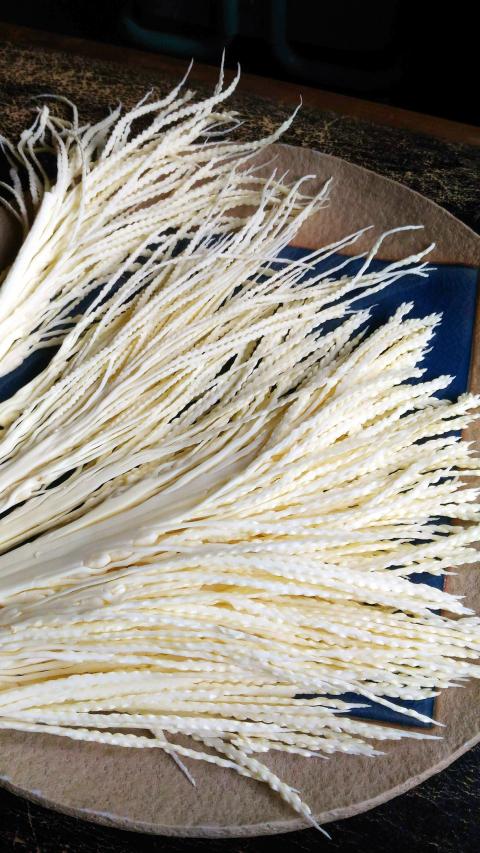Few foods come with as many health caveats as betel nut, the chewing of which remains closely associated with Taiwanese culture despite strenuous government effort to discourage the practice. The betel nut has psychoactive substances that promote its use as a stimulant, and it is sold around Taiwan, most famously by betel nut beauties, scantily clad women who are displayed in glass shop fronts.
HEALTH HAZARD
The beauties have gained Taiwan some international notoriety, but apart from the sexual exploitation inherent in this manner of marketing, the chewing of betel nut is also closely associated with oral and other cancers and its use generally acknowledged as a health hazard.

Photo: Ian Bartholomew
That said, it remains a highly valuable crop and huge areas are dedicated to its cultivation, particularly fragile hillside lands in southern Taiwan, where it is responsible for server environmental degradation. It is widely accepted as a major culprit in a number of devastating mud slides that have destroyed lives and communities. It’s high value means that efforts to curb the planting of betel nut around Taiwan have had limited effect and it is still a major feature of scenery in southern Taiwan.
Overall, there is really not much of an upside to betel nut as a commercial crop. Nevertheless, one culinary curiosity does emerge from this harmful agriculture. This is the betel nut flower (檳榔花), which is sometimes found on the menus of Taiwanese eateries dealing in local specialties and the cuisine of Taiwan’s indigenous peoples.
Despite the notoriety of the betel nut and its close association with Taiwan culture, betel nut flower is not a regular feature in the supermarket vegetable aisle. It has a relatively short season around this month, and is most likely to be found in traditional markets. In restaurants, it is usually served either stir fried or as a cold dish, appreciated for its crunchy texture.

Photo: Ian Bartholomew
The reason that the government seeks to discourage the chewing of betel nut is for the simple fact that this habit can cause cancer, particularly of the mouth. The fact that it remains popular is due to its effects as a powerful stimulant, and despite best efforts, remains popular, particularly among Taiwan’s working class who use it to get thought the physical demands of manual labor or soul-crushingly long hours behind the wheel of long haul trucks.
It is no coincidence that major highway interchanges in southern Taiwan remain a focal point for the betel nut beauties, providing the double whammy of sexual titillation and drug-induced vitality. Cancer, the gradual disintegration of teeth, foul breath, a diseased mouth and throat, can all seem like a high price to pay for a momentary high.
Despite its ill effects, like many expats in Taiwan, I have tested its psychoactive properties as part of the “Taiwan experience.” For myself, a single test was enough to put any notion of establishing solidarity with the Taiwan working class through the participation in the betel nut ritual behind me.
Others have found betel nut to be an interesting and exciting experience, so I will not seek to judge on this issue, but it should be emphasized that regardless of the kind of high you can get from betel nut, the powerful alkaloids it contains will certainly not do you any good in the long run. Betel nut is most often sold with flavoring agents such as slacked lime that (slightly) improve its flavor, but which have terrible effects on oral health and hygiene.
While the flower does not present the carcinogenic dangers of the nut, most sources recommend its consumption only in moderation, as it contains alkaloids such as arecoline, which can lead to sweating and difficulty in breathing. Nausea, vomiting and stomach pain are also associated with excessive consumption of betel nut flower.
NOT ALL DOOM AND GLOOM
It is not all doom and gloom for the betel nut flower, as eaten in moderation it can stimulate digestion and some studies have even shown that arecoline in some forms may be active in retarding the onset of dementia. Betel nut also has a number of uses in ayurvedic medicine.
On the culinary front, the betel nut flower is prized for its crunchy texture and its fresh flavor that can stand out even against strong flavors. As delicious as it is, I am only able to eat it in very small quantities, primarily due to the fact that while the chemical properties of the flower are much slighter than that of the nut, I find that after three or four mouthfuls, I sometimes feel a quite distinct nicotine buzz. For those who like this sensation, betel nut flower is a must-try, but for myself, I find the whole experience rather disturbing.
Another part of the appeal of betel nut flower for the culinary adventurer is its appearance. Its ivory fronds are really rather beautiful and I can fully appreciate its appeal both as a visual and flavor element of a dish, but in all honesty eating betel nut flower is more about engaging with the Taiwan experience rather than having a healthy culinary experience.
Fried Betel Nut Flower with Chinese Mushrooms
Recipe
(serves two)
It may be the simple lack of culinary invention, but betel nut flower is generally served in one of only two methods. It is either fried or blanched in boiling water and dressed with a spicy savory dressing. The combination with Chinese mushrooms is a standard combination and a sprinkling of chili is very handy in bringing out the flavor of the betel nut flower and an addition I would strongly recommend even if you are not particularly partial to spicy flavors. While I enjoy the flavor and texture of betel nut flower, I sometimes find that some batches have a more powerful effect than others, and while I can enjoy the flower simply as a vegetable, on occasion I do feel that it is also providing a sometimes not entirely welcome narcotic effect. This is something to be aware of when preparing this dish.
Ingredients
200g betel nut flower, fronds cut
into segments
100g preserved pork belly
20g dried Chinese mushrooms
2 cloves of garlic, minced
2 stems spring onion, cut into segments
2 tbsp olive oil
salt and white pepper to season
Directions
1. Blanch the preserved pork belly in boiling water for about 5 minutes. Allow to cool and slice thinly.
2. Soak the Chinese mushrooms in boiling water for about 5 minutes, or until soft, then cut away the stem, and slice finely. The water can be discarded.
3. Heat a skillet and add oil over low heat. Put in the preserved pork belly and allow the fat to render slightly, about 3 minutes. Add the garlic and fry for another minute until fragrant.
4. Add the sliced Chinese mushroom and spring onions. Turn up heat to medium and fry for another minute. Add the betel nut flower segments and stir, coating the fronds in the fragrant oil. Cook for about 2 minutes. The fronds should remain crunchy.
5. Season with salt and white pepper. Serve with white rice.
Ian Bartholomew runs Ian’s Table, a small guesthouse in Hualien. He has lived in Taiwan for many years writing about the food scene and has decided that until you look at farming, you know nothing about the food you eat. He can be contacted at Hualien202@gmail.com.

President William Lai (賴清德) yesterday delivered an address marking the first anniversary of his presidency. In the speech, Lai affirmed Taiwan’s global role in technology, trade and security. He announced economic and national security initiatives, and emphasized democratic values and cross-party cooperation. The following is the full text of his speech: Yesterday, outside of Beida Elementary School in New Taipei City’s Sanxia District (三峽), there was a major traffic accident that, sadly, claimed several lives and resulted in multiple injuries. The Executive Yuan immediately formed a task force, and last night I personally visited the victims in hospital. Central government agencies and the

Australia’s ABC last week published a piece on the recall campaign. The article emphasized the divisions in Taiwanese society and blamed the recall for worsening them. It quotes a supporter of the Taiwan People’s Party (TPP) as saying “I’m 43 years old, born and raised here, and I’ve never seen the country this divided in my entire life.” Apparently, as an adult, she slept through the post-election violence in 2000 and 2004 by the Chinese Nationalist Party (KMT), the veiled coup threats by the military when Chen Shui-bian (陳水扁) became president, the 2006 Red Shirt protests against him ginned up by

As with most of northern Thailand’s Chinese Nationalist Party (KMT) settlements, the village of Arunothai was only given a Thai name once the Thai government began in the 1970s to assert control over the border region and initiate a decades-long process of political integration. The village’s original name, bestowed by its Yunnanese founders when they first settled the valley in the late 1960s, was a Chinese name, Dagudi (大谷地), which literally translates as “a place for threshing rice.” At that time, these village founders did not know how permanent their settlement would be. Most of Arunothai’s first generation were soldiers

Among Thailand’s Chinese Nationalist Party (KMT) villages, a certain rivalry exists between Arunothai, the largest of these villages, and Mae Salong, which is currently the most prosperous. Historically, the rivalry stems from a split in KMT military factions in the early 1960s, which divided command and opium territories after Chiang Kai-shek (蔣介石) cut off open support in 1961 due to international pressure (see part two, “The KMT opium lords of the Golden Triangle,” on May 20). But today this rivalry manifests as a different kind of split, with Arunothai leading a pro-China faction and Mae Salong staunchly aligned to Taiwan.